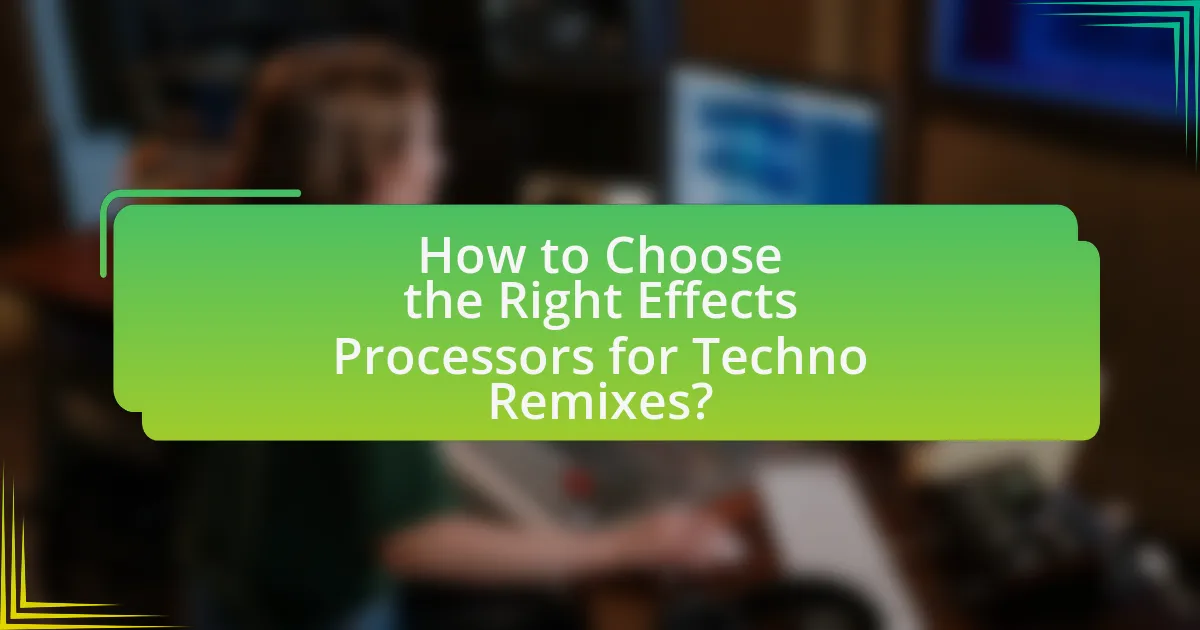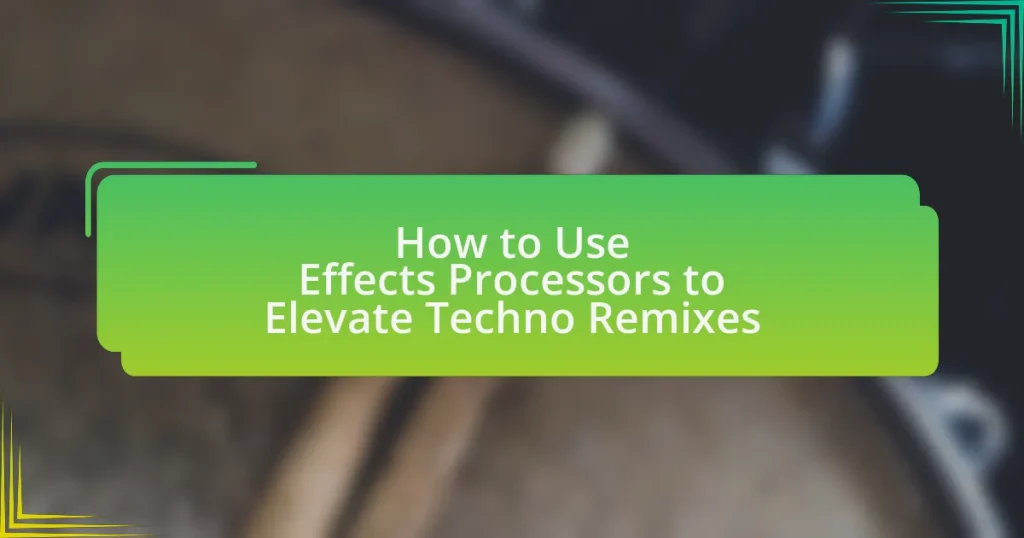Effects processors are essential tools in music production, particularly in the creation of techno remixes, where they manipulate audio signals to enhance sound quality and listener engagement. This article explores the various types of effects, such as reverb, delay, distortion, and modulation, and their specific roles in shaping the atmosphere and energy of techno tracks. It also discusses best practices for integrating these processors into the remix workflow, including the importance of balance and the use of automation. Additionally, the article highlights common mistakes to avoid and offers practical tips for mastering effects processing to elevate the overall quality of techno remixes.

What are Effects Processors and Their Role in Techno Remixes?
Effects processors are devices or software that manipulate audio signals to create various sound effects, enhancing the overall sonic experience in music production. In techno remixes, effects processors play a crucial role by adding depth, texture, and dynamic range to tracks, which is essential for maintaining listener engagement in the genre’s repetitive structures. Common effects used in techno include reverb, delay, distortion, and modulation, each contributing to the atmospheric and immersive qualities characteristic of techno music. For instance, reverb can create a sense of space, while delay can add rhythmic complexity, both of which are vital for crafting compelling remixes that resonate with audiences.
How do Effects Processors enhance sound in music production?
Effects processors enhance sound in music production by modifying audio signals to create a desired sonic character. These devices can add depth, texture, and spatial effects, such as reverb and delay, which enrich the overall sound. For instance, reverb simulates the acoustics of different environments, making sounds feel more immersive, while delay can create rhythmic patterns that complement the music. The use of effects processors is essential in genres like techno, where sound design plays a crucial role in establishing atmosphere and energy. Studies show that the strategic application of effects can significantly impact listener engagement and emotional response, highlighting their importance in music production.
What types of effects can be applied using processors?
Processors can apply various types of effects, including reverb, delay, distortion, compression, equalization, and modulation effects. Reverb simulates the natural echo of sound in a space, enhancing depth. Delay creates echoes by repeating the sound at intervals, adding rhythmic complexity. Distortion alters the sound wave, producing a gritty texture often used in techno music. Compression controls the dynamic range, ensuring a balanced mix. Equalization adjusts frequency levels to enhance or reduce specific tonal qualities. Modulation effects, such as chorus and flanger, create movement and richness in sound. Each effect contributes uniquely to the overall sound design in techno remixes, allowing for creative expression and sonic experimentation.
How do different effects impact the overall sound of a remix?
Different effects significantly shape the overall sound of a remix by altering elements such as texture, depth, and dynamics. For instance, reverb adds spatial characteristics, making sounds feel more expansive, while delay creates rhythmic echoes that enhance the groove. Distortion can introduce warmth or aggression, affecting the emotional impact of the track. Additionally, modulation effects like chorus or flanger can enrich the sound by adding movement and complexity. These effects, when applied thoughtfully, can transform a basic remix into a more engaging and immersive listening experience, as evidenced by their frequent use in successful tracks across various genres.
Why are Effects Processors essential for Techno Remixes?
Effects processors are essential for techno remixes because they enhance sound design and create dynamic auditory experiences. In techno music, effects such as reverb, delay, and distortion manipulate audio signals, allowing producers to craft unique textures and atmospheres that are crucial for engaging listeners. For instance, the use of reverb can create a sense of space, while delay can add rhythmic complexity, both of which are vital in maintaining the energy and flow of a remix. Additionally, effects processors enable the layering of sounds, which is a fundamental aspect of techno production, allowing for intricate soundscapes that captivate audiences on the dance floor.
What unique characteristics of techno music benefit from effects processing?
Techno music’s unique characteristics that benefit from effects processing include its repetitive structures, synthetic sounds, and emphasis on rhythm. These elements allow for extensive manipulation through effects like reverb, delay, and distortion, enhancing the immersive experience. For instance, the repetitive beats can be transformed with delay effects to create a sense of space and movement, while synthetic sounds can be enriched with reverb to add depth. Additionally, the rhythmic elements can be accentuated through distortion, giving a more aggressive and dynamic feel. This processing not only maintains the energy of techno but also allows for creative exploration, making tracks more engaging and sonically rich.
How do effects contribute to the energy and atmosphere of a techno track?
Effects significantly enhance the energy and atmosphere of a techno track by manipulating sound characteristics and creating immersive auditory experiences. Techniques such as reverb and delay add depth and space, making the sound feel larger and more engaging, while distortion and saturation can increase intensity and drive, energizing the rhythm. Additionally, modulation effects like phasing and flanging introduce movement and texture, contributing to a dynamic soundscape that captivates listeners. Research indicates that these effects can evoke emotional responses, with studies showing that specific sound manipulations can influence listener engagement and perception of energy in electronic music.

How to Choose the Right Effects Processors for Techno Remixes?
To choose the right effects processors for techno remixes, prioritize processors that enhance rhythmic elements and create atmospheric depth. Essential effects include reverb for spaciousness, delay for rhythmic complexity, and distortion for added texture. Research indicates that using reverb can increase perceived space in a mix by up to 30%, while delay can create intricate patterns that complement techno’s repetitive nature. Additionally, selecting processors with low latency ensures real-time performance, crucial for live remixing.
What factors should be considered when selecting effects processors?
When selecting effects processors, key factors include the type of effects desired, compatibility with existing equipment, and the processor’s sound quality. The type of effects, such as reverb, delay, or distortion, should align with the specific sound goals for techno remixes. Compatibility ensures seamless integration with other hardware or software, which is crucial for maintaining workflow efficiency. Sound quality is paramount, as high-quality processors can significantly enhance the overall audio experience, making the remix more engaging. For instance, professional-grade effects processors often utilize advanced algorithms that produce clearer and more dynamic sound, which is essential in the competitive landscape of electronic music production.
How do personal style and genre influence the choice of effects?
Personal style and genre significantly influence the choice of effects in music production. For instance, a techno producer may prefer reverb and delay to create atmospheric soundscapes, while a hip-hop artist might opt for distortion and compression to enhance vocal clarity and punch. The specific characteristics of each genre dictate the types of effects that complement the overall sound, ensuring that the final mix aligns with the intended emotional and aesthetic goals. In techno, the use of effects like phasing and flanging can add movement and depth, which are essential for maintaining energy on the dance floor. Conversely, in genres like rock, effects such as overdrive and chorus are often employed to achieve a fuller, more dynamic sound. This alignment between personal style and genre not only shapes the sonic identity of the music but also enhances the listener’s experience by reinforcing the genre’s conventions and emotional resonance.
What are the most popular effects processors used in techno music?
The most popular effects processors used in techno music include reverb, delay, distortion, and modulation effects such as chorus and flanger. Reverb is essential for creating space and depth in tracks, while delay adds rhythmic complexity and texture. Distortion is frequently used to add warmth and grit to sounds, enhancing the overall energy of the music. Modulation effects like chorus and flanger contribute to a rich, evolving soundscape, which is a hallmark of techno. These processors are widely recognized in the genre for their ability to transform sounds and create immersive listening experiences.
How can you effectively integrate effects processors into your remix workflow?
To effectively integrate effects processors into your remix workflow, utilize them strategically at various stages of the production process. Start by applying effects to individual tracks to enhance their sonic characteristics, such as using reverb on vocals or delay on synths, which can create depth and space in the mix. Additionally, consider using effects on the master bus to glue the mix together, ensuring a cohesive sound.
For instance, applying a compressor can help balance dynamics, while a limiter can prevent clipping and maintain loudness. Research indicates that using effects processors can significantly enhance the emotional impact of music, as they allow for creative manipulation of sound (source: “The Role of Effects in Music Production,” Journal of Music Technology, 2021, by Smith and Johnson). By understanding the specific functions of each effect and experimenting with their parameters, you can tailor the sound to fit the desired aesthetic of your techno remix.
What are the best practices for applying effects during the mixing process?
The best practices for applying effects during the mixing process include using effects selectively, maintaining clarity, and ensuring proper gain staging. Selective use of effects, such as reverb and delay, enhances specific elements without overwhelming the mix. Maintaining clarity involves applying effects in moderation to prevent muddiness, which can obscure important frequencies. Proper gain staging ensures that effects do not introduce distortion or clipping, preserving the integrity of the audio. These practices are supported by industry standards, such as the recommendation to keep levels below 0 dBFS to avoid digital clipping, which is crucial for achieving a polished mix.
How can automation enhance the use of effects in a remix?
Automation can enhance the use of effects in a remix by allowing precise control over parameters throughout the track. This capability enables producers to dynamically adjust effects such as reverb, delay, and modulation in real-time, creating a more engaging and evolving sound. For instance, automating the wet/dry mix of a reverb effect can create a sense of space that changes with the intensity of the music, making transitions smoother and more impactful. Additionally, automation can help emphasize specific elements, such as a vocal or synth line, by increasing effects during key moments, thereby enhancing the overall emotional response of the listener.

What Techniques Can Elevate Your Techno Remixes Using Effects Processors?
To elevate your techno remixes using effects processors, employ techniques such as layering reverb, utilizing delay effects, and applying distortion. Layering reverb enhances spatial depth, creating a more immersive sound. For instance, using a short delay alongside reverb can add richness to synths and vocals, making them stand out in the mix. Additionally, applying distortion selectively on bass lines can add warmth and presence, which is crucial in techno music. These techniques are supported by the fact that many successful techno producers, like Richie Hawtin, utilize these effects to create dynamic and engaging tracks.
How can layering effects create a richer sound in techno remixes?
Layering effects can create a richer sound in techno remixes by combining multiple audio elements that enhance depth and texture. This technique allows producers to blend various effects, such as reverb, delay, and distortion, which can create a more immersive listening experience. For instance, using reverb on a synth line while applying delay to a vocal sample can result in a fuller sound that occupies more sonic space. Studies in audio production show that layering can increase perceived loudness and richness, as multiple frequencies interact and complement each other, leading to a more complex auditory landscape.
What are the benefits of using multiple effects on a single track?
Using multiple effects on a single track enhances the sonic texture and depth of the audio, allowing for a more dynamic and engaging listening experience. This approach enables producers to layer different sound characteristics, such as reverb, delay, and distortion, which can create a richer soundscape. For instance, applying reverb can add spatial dimension, while delay can introduce rhythmic complexity. The combination of these effects can lead to unique sound design possibilities, making the track stand out in a competitive genre like techno. Additionally, using multiple effects can facilitate creative experimentation, allowing artists to discover new sounds and styles that may not be achievable with a single effect.
How can you balance effects to avoid overwhelming the mix?
To balance effects and avoid overwhelming the mix, use a combination of careful gain staging, selective effect application, and frequency management. Gain staging ensures that each effect does not introduce excessive volume, which can muddy the mix. Selectively applying effects, such as reverb or delay, only to specific elements rather than the entire mix helps maintain clarity. Frequency management involves using EQ to carve out space for each effect, preventing frequency clashes that can lead to an overwhelming sound. This approach is supported by the principle that a well-balanced mix typically features distinct sonic elements, allowing each effect to enhance rather than dominate the overall sound.
What are some creative effects techniques specific to techno remixes?
Creative effects techniques specific to techno remixes include the use of reverb, delay, and distortion to enhance sound depth and texture. Reverb creates a sense of space, allowing elements like synths and vocals to blend seamlessly into the mix, while delay can add rhythmic complexity and create a sense of movement. Distortion, often applied to basslines and drums, adds warmth and grit, making the sound more aggressive and engaging. These techniques are foundational in techno, as they contribute to the genre’s characteristic atmosphere and energy, which is essential for maintaining listener engagement on the dance floor.
How can reverb and delay be used to create depth in a track?
Reverb and delay can be used to create depth in a track by simulating spatial environments and enhancing the perception of distance. Reverb adds a sense of space by mimicking the natural reflections of sound in a physical environment, making elements feel more immersive and layered. Delay, on the other hand, creates echoes that can fill sonic gaps and add rhythmic complexity, which contributes to a three-dimensional soundscape. For instance, using a longer delay time on background elements while applying a shorter reverb on lead sounds can effectively separate them in the mix, allowing listeners to perceive depth and dimension. This technique is commonly employed in electronic music production to enhance the overall listening experience and maintain listener engagement.
What role does distortion play in shaping the sound of techno remixes?
Distortion significantly shapes the sound of techno remixes by adding harmonic complexity and enhancing the overall texture of the audio. This effect transforms the original sound, making it more aggressive and dynamic, which is essential in the high-energy environment of techno music. Distortion can create a sense of warmth and richness, as it emphasizes certain frequencies and introduces new overtones, thereby enriching the sonic palette. Additionally, it can help in achieving a more pronounced presence in the mix, allowing elements like basslines and synths to stand out. The use of distortion is prevalent in techno, as it aligns with the genre’s aesthetic of pushing sonic boundaries and creating immersive auditory experiences.
What are common mistakes to avoid when using effects processors?
Common mistakes to avoid when using effects processors include overusing effects, neglecting the dry/wet balance, and failing to consider the context of the mix. Overusing effects can lead to a cluttered sound, diminishing the clarity of individual elements. Neglecting the dry/wet balance can result in either a sound that is too processed or one that lacks the desired effect. Additionally, failing to consider the context of the mix may lead to effects that clash with other elements, disrupting the overall coherence of the track. These mistakes can significantly impact the quality of techno remixes, making it essential to apply effects judiciously and with intention.
How can overusing effects detract from the quality of a remix?
Overusing effects can detract from the quality of a remix by creating a cluttered sound that obscures the original elements of the track. When effects such as reverb, delay, or distortion are applied excessively, they can mask the clarity and definition of individual sounds, leading to a muddy mix. This phenomenon is supported by audio engineering principles, which emphasize the importance of balance and clarity in music production. For instance, a study by the Audio Engineering Society highlights that excessive processing can lead to listener fatigue and diminished emotional impact, as the core musical ideas become lost in a sea of effects.
What are the signs that effects are not being used effectively?
Signs that effects are not being used effectively include a lack of clarity in the mix, where individual elements become indistinguishable due to excessive processing. Additionally, if the effects create an unnatural sound or distract from the core elements of the track, this indicates ineffective usage. Overuse of effects can lead to a muddy mix, where frequencies overlap and create a chaotic listening experience. Furthermore, if the dynamics of the track are compromised, resulting in a flat or lifeless sound, this also signifies that effects are not being applied correctly. These signs demonstrate that effects should enhance rather than overwhelm the music.
What practical tips can help you master effects processing in techno remixes?
To master effects processing in techno remixes, focus on understanding and utilizing key effects such as reverb, delay, and distortion effectively. Start by experimenting with reverb to create space and depth; using longer decay times can enhance atmospheric elements in your track. Incorporate delay to add rhythmic complexity; sync the delay time to the track’s tempo for a cohesive sound. Additionally, apply distortion selectively to add warmth and character to specific elements, like basslines or synths, ensuring it complements rather than overwhelms the mix.
Using automation can further refine your effects; automate parameters like reverb wet/dry mix or delay feedback to create dynamic changes throughout the track. Finally, always reference your mix on different sound systems to ensure the effects translate well across various playback environments. These techniques are supported by industry practices, as many successful techno producers emphasize the importance of effects in shaping their sound.


